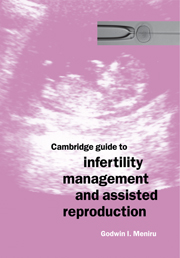Book contents
- Frontmatter
- Contents
- Preface
- Foreword
- Acknowledgements
- Introduction
- 1 The male reproductive system
- 2 The female reproductive system
- 3 Fertilization, implantation and early development
- 4 Male factor problems
- 5 Female factor problems
- 6 Evaluation of the infertile couple
- 7 Medical and surgical treatment of infertility
- 8 Conventional in-vitro fertilization treatment
- 9 Intracytoplasmic sperm injection
- 10 Surgical sperm retrieval
- 11 Intratubal replacement of gametes and embryos (GIFT, ZIFT)
- 12 Intrauterine insemination
- 13 Cryopreservation of gametes, ovarian tissue, testicular tissue and embryos; frozen embryo replacement
- 14 Assisted hatching
- 15 Preimplantation diagnosis of genetic disease
- Appendix: Acronyms in assisted reproduction technology
- Index
8 - Conventional in-vitro fertilization treatment
Published online by Cambridge University Press: 11 September 2009
- Frontmatter
- Contents
- Preface
- Foreword
- Acknowledgements
- Introduction
- 1 The male reproductive system
- 2 The female reproductive system
- 3 Fertilization, implantation and early development
- 4 Male factor problems
- 5 Female factor problems
- 6 Evaluation of the infertile couple
- 7 Medical and surgical treatment of infertility
- 8 Conventional in-vitro fertilization treatment
- 9 Intracytoplasmic sperm injection
- 10 Surgical sperm retrieval
- 11 Intratubal replacement of gametes and embryos (GIFT, ZIFT)
- 12 Intrauterine insemination
- 13 Cryopreservation of gametes, ovarian tissue, testicular tissue and embryos; frozen embryo replacement
- 14 Assisted hatching
- 15 Preimplantation diagnosis of genetic disease
- Appendix: Acronyms in assisted reproduction technology
- Index
Summary
Introduction
The first birth in 1978 following in vitro fertilization (IVF) treatment (Steptoe & Edwards, 1978) marked the beginning of a rapid expansion of treatment modalities available to infertile couples as well as an improvement in success rates. IVF and many other assisted conception treatments are now routinely carried out in clinical practice and are proving to be more efficient and cost effective than some traditional medical remedies, such as tubal surgery for example, in certain classes of patients. Conventional IVF is the name given to the original ‘test tube baby’ treatment method and involves addition of a measured volume of prepared sperm suspension to a dish containing the retrieved oocytes. Most other variants of conventional IVF still share several similarities with it. Where they differ is mainly in the method used to procure fertilization of the oocytes and the site of deposition of the gametes or embryos in the female genital tract. The various stages of conventional IVF treatment will now be described. Other assisted conception treatment methods will be described in subsequent chapters. It is important that practical information similar to that contained in the following account is made available to infertile couples by their carers. Couples who are aware of all aspects of their treatment will be more co-operative since they know exactly what to expect and when. Most importantly they are fully informed on issues such as success rates of the treatment, complications and possible side-effects.
- Type
- Chapter
- Information
- Publisher: Cambridge University PressPrint publication year: 2001



